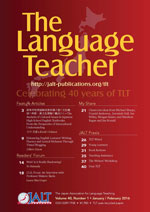In this month’s issue . . .
 Happy New Year! It seems like only yesterday we were welcoming TLT’s 30th anniversary in 2006, and now 2016 is already upon us. Happy 40th to TLT! We are excited to share with you another issue of TLT with new and thrilling content.
Happy New Year! It seems like only yesterday we were welcoming TLT’s 30th anniversary in 2006, and now 2016 is already upon us. Happy 40th to TLT! We are excited to share with you another issue of TLT with new and thrilling content.
Japan’s relationship with other countries in the East Asian region is a prominent topic in higher education. The Ministry of Education, Culture, Sports, Science, and Technology (MEXT) has stressed the globalisation of education with a specific focus on the East Asian region, but are textbook publishers paying attention? Our first Feature Article, “The Analysis of Cultural Issues in Japanese High School English Textbooks: From the Perspective of Intercultural Understanding”, by Kouki Ookawa, suggests that cultures where English is spoken as a second language in East Asia are significantly under-represented in textbooks. Read on to find out more. Our second Feature Article will likely be of interest to many teachers. “Enhancing English Learners’ Writing Fluency and Lexical Richness Through Timed Blogging”, by Gilbert Dizon, introduces the ubiquitous blog in computer-assisted language learning (CALL), and explores two questions about the effect blogs have on writing fluency and lexical richness.
Next, we move onto the Readers’ Forum. Shadowing and repetition are two well-known activities used in English language teaching classes. However, is there a difference between them? Our first Readers’ Forum article, “Wait! Is it Really Shadowing?”, by Yo Hamada, takes a detailed look at the differences between the two and examines their effect on listening and reading skills. Our second Readers’ Forum offering directs us toward the challenge of globalising education in Japan. Sophia University has taken up this challenge through teaching content courses in a similar way to language courses by incorporating content and language integrated learning (CLIL). Laura MacGregor interviews CLIL pioneer Makoto Ikeda about incorporating the principles of CLIL in the classroom. Peruse the Readers’ Forum to get the latest information.
Finally, we hope you enjoy this issue and look forward to your comments and feedback.
Glenn Magee, TLT Co-Editor
あけましておめでとうございます。2006年のTLT30周年が昨日のことのように思い出されますが、ついに2016年を迎え、TLT40周年を祝う時が来ました! 今後も引き続き新鮮で心躍る内容満載のTLTをお届けします。
国際化の中で日本と東アジアとの関係は高等教育の注目の的です。文部科学省は東アジアを見据えた国際化を強調していますが、教科書出版社はそれにどう対応しているでしょうか。今月号の最初のFeatureはKouki Ookawaの“The Analysis of Cultural Issues in Japanese High School English Textbooks: From the Perspective of Intercultural Understanding”で、国際理解の観点から日本の高校教科書で扱われている多文化を分析し、英語を第2言語としている東アジアの文化がそれらの教科書で十分に扱われていないことを論じています。2つ目のFeatureは、多くの教育者が共感されるでしょう。Gilbert Dizonが“Enhancing English learners’ writing fluency and lexical richness through timed blogging”でCALL授業にブログを用いる方法を紹介し、ライティングの流暢さと語彙力増強への効果について考察しています。
さて、シャドーイングと反復は英語授業でよく使われる方法ですが、その違いをご存じでしょうか。最初のReaders’ Forumでは、Yo Hamadaが“Wait! Is it really shadowing?”で違いを詳しく調べ、リスニングとリーディングへの影響に着目します。2つ目のReaders’ Forumは日本における国際化教育の取り組みに関するものです。上智大学はCLIL (Content and Language Integrated Learning) を組み込むことで、英語を教えるのではなく、英語を使って教科の内容を教える授業に挑んでいます。Laura MacGregor が教室でのCILL理論の用い方について、そのパイオニアであるMakoto Ikedaにインタビューします。最新の情報をお見逃しのないようによくお読みください。
最後にスタッフ一同、みなさまがこの新年号を楽しんでくださることをお祈りします。コメントやご意見も楽しみにお待ちしております。
Glenn Magee, TLT Co-Editor


